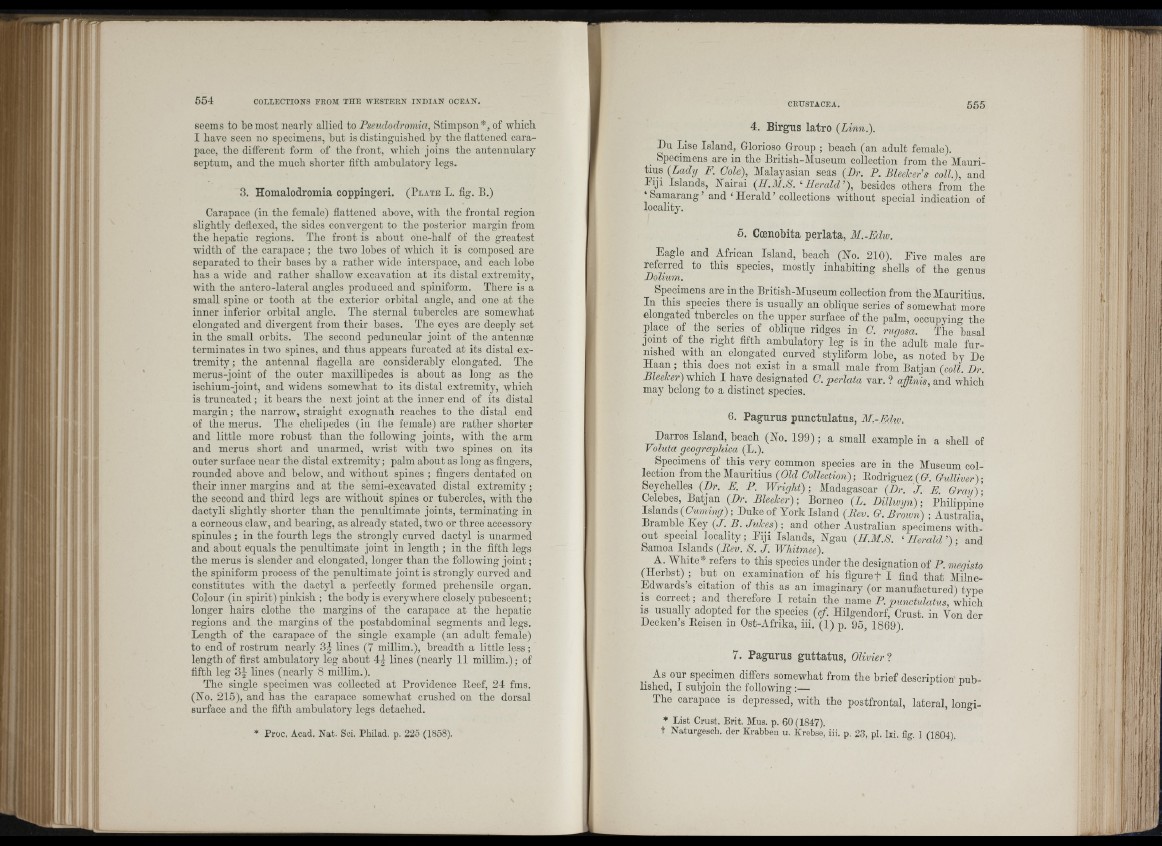
a
i :
if'
seems to be most nearly allied to Pseudodromia, Stimpson*, of wbicb
I bave soon no specimens, but is distinguisbed by tbe flattened carapace,
the different form of the front, wliich joins tbe antennulary
septum, and tbe mucb shorter fifth ambulatory legs.
3. Homalodromia coppingeri. (P late L. fig. P .)
Carapace (in tbe female) flattened above, witb the frontal region
slightly defiexed, tbe sides convergent to tbe posterior margin from
the hepatic regions. Tbe front is about oue-balf of tbe greatest
width of tbe carapace ; tbe two lobes of which it is composed are
separated to their bases by a ratber wide interspace, and each lobe
has a wide and ratber shallow excavation at its distal extremity,
witb tbe antero-lateral angles produced and spiniform. There is a
small spine or tooth at tbe exterior orbital angle, and ono at the
inner inferior orbital angle. The sternal tubercles are somewhat
elongated and divergent from their bases. Tbe eyes are deeply set
in tbe small orbits. Tbe second peduncular joint of the antennae
terminates in two spines, and thus appears furcated at its distal extremity
; tbe antennal flagella are considerably elongated. The
merus-joint of tbe outer maxillipedes is about as long as tbe
iscbium-joint, and widens somewhat to its distal extremity, which
is tru n ca ted ; it bears the next joint at the inner end of its distal
m argin; tbe narrow, straight exognath reaches to tbe distal end
of the merus. The chelipedes (in the female) are ratber shorter
and little more robust than tbe following joints, with tbe arm
and merus short and unarmed, wrist with two spines on its
outer surface near the distal extremity; palm about as long as fingers,
rounded above and below, and without spines ; fingers dentated on
their inner margins and at the semi-excavated distal ex trem ity ;
tbe second and third legs are without spines or tubercles, witb tbe
dactyli slightly shorter than the penultimate joints, terminating in
a corneous claw, and bearing, as already stated, two or three accessory
spinules ; in the fourtb legs tbe strongly curved dactyl is unarmed
and about equals the penultimate joint in length ; in the fifth legs
tbe merus is slender and elongated, longer than the following jo in t;
the spiniform process of the penultimate joint is strongly curved and
constitutes witb the dactyl a perfectly formed prehensile organ.
Colour (in spirit) pinkish ; tbe body is everywhere closely pubescent;
longer hairs clothe the margins of the carapace at tbe hepatic
regions and the margins of tbe postahdominal segments and legs.
Length of the carapace of tbe single example (an adult female)
to end of rostrum nearly 3 | lines (7 millim.), breadth a little less;
length of first ambulatory leg about 4^ lines (nearly 11 millim.); of
fifth leg 3 / lines (nearly 8 millim.).
The single specimen was collected at Providence Peef, 24 fms.
(No. 215), and has the carapace somewhat crushed on the dorsal
surface and the fifth ambulatory legs detached.
* Proc. Acad. Nat. Sci. Philad. p. 225 (1858).
4. BirgHS latro {Linn.).
Du Lise Island, Glorioso Group ; beach (an adult female).
_ Specimens are in tbe British-Aluseum collection from tbe Alauritius
{Lady F. Cole), Alalayasian seas {Dr. P. BleelcePs coll.), and
Liji Islands, Nairai {H.Al.S. ‘Hera ld ’), besides others from the
‘ Samarang ’ and ‘ Herald ’ collections without special indication of
locality.
5. CceHobita perlata, M.-Edw.
Eagle and African Island, beach (No. 210). Eive males are
referred to tbis species, mostly inhabiting shells of tbe genus
Dolium.
Specimens are in tbe Britisb-AIusenm collection from tbe Alauritius.
In this species there is usually an oblique series of somewhat moré
elongated tubercles on tbe upper surface of tbe palm, occupying tbe
place of tbe series of oblique ridges in C. rugosa. The ”basal
joint of the right fifth ambulatory leg is in the adult male furnished
with an elongated curved styliform lobe, as noted by De
H a a n ; this does not exist in a small male from Batjan {coll. Dr.
Bleeker) wbicb I have designated 0. perlata var. ? affinis, and which
may belong to a distinct species.
6. Pagurus punctulatus, M.-Ediu.
Darros Island, beach (No. 199); a small example in a shell of
Voluta geograpliica (L.).
Specimens of this very common species aro in the Aluseum collection
from the Alauritius {Old Collection); Eodriguez {G. Gulliver) ■
Seychelles {Dr. E. P. Wright); Aladagascar {Dr. J. E Gray)-
Celebes, Batjan {Dr. Bleeker); Borneo {L. Dilhuyn); Pbilippiné
Islands ((7-iimtn5r); Duke of York Island {Bev. G. Brown) ; Australia
Bramble Key {J. B. Jukes) ; and other Australian specimens without
special locality; Eiji Islands, Ngau {H.M.S. ‘H era ld ’) - and
Samoa Islands {Bev. S. J. Whitmee). ’
A. White* refers to tbis species under the designation of P. megisto
(Herbst)^; but on exammation of his figuref I find th at Alilne-
Edwards’s citation of this as an imaginary (or manufactured) type
is correct; and therefore I retain tbe name P. punctulatus, which
IS usually adopted for the species {cf. Hilgendorf, Crust, in Von der
Decken’s Eeisen in Ost-Afrika, iii. (1) p. 95, 1869).
7. Pagurus guttatus, Olivieri
_ As our specimen differs somewhat from the brief description published,
I subjoin tbe following :—
Tbe carapace is depressed, witb the postfrontal, lateral, longi-
* List Crust. Brit. Mus. p. 60(1847).
t Naturgescb. der Krabben u. Krebse, iii. p. 23, pi. lii. fig. ] (1804).
! I.